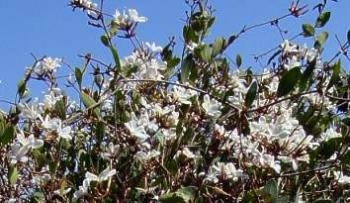Ancylobotrys capensis
Ancylobotrys capensis (Oliv.) Pichon
Family: Apocynaceae
Common names: rock milk apricot, wild apricot, dwarf wild apricot, wild peach ( Eng. ); klipmelkappelkoos, wilde-appelkoos, wilde-perske (Afr.); morobe (Northern Sotho); umdongwe (Zulu)
Introduction
The fragrant, hardy, indigenous wild apricot, Ancylobotrys capensis, is a good substitute for the Chinese jasmine (Jasminum polyanthum) the scent of which fills the air around Pretoria in springtime. You may, as an added benefit, also be rewarded with a harvest of juicy fruit later in the season. Patient gardeners looking for a challenge or not knowing what to plant in difficult rocky patches in a highveld garden should try to establish Ancylobotrys capensis in their garden.

Description
Description
The rock milk apricot is an evergreen, multistemmed, densely branched, scrambling shrub, 1-2 m high or a lean, intertwining climber in which case it reaches heights of up to 5 m. The young branches and growth points are covered with soft, reddish brown hairs. The bark is reddish brown to greyish brown. All parts of the plant contain milky, rubbery latex.
The simple, opposite leaves are characteristically carried upright. They are leathery are oblong to broadly elliptic, 20-60 x 12-25 mm in dimension, dark green above and paler below and have pronounced herringbone veins on both sides.

The flower tube and segments are pinkish to reddish orange to white on the outside and brilliant white on the inside. The flowers are large and up to 30 mm wide, borne in dense, showy clusters at the tips of branches, and are sweetly scented.

The fruit are rounded to pear-shaped and 35-50 mm in diameter. They are dark green to lime-green when young, turning yellow to orange as they mature. The skin is somewhat fleshy and velvety and tough, but peels away easily. Inside are numerous seeds, varying from round to almost bean-like and embedded in the sweet-sour pulp. The fruit resembles the apricot in colour but the taste is certainly different - the flesh is tasty and slightly sour, especially close to the seed.

Distribution and habitat
Distribution description
Ancylobotrys capensis occurs naturally in northern KwaZulu-Natal, Mpumalanga, Gauteng, Limpopo Province, North-West Province and southeastern Botswana. The wild apricot is a characteristic species of dry bush in rocky situations and grows in grassland and bushveld, mainly on the scarp and summit of rocky outcrops or on plains with rocky ridges. It is widely distributed and found frequently. It is common on quartzite koppies mainly in the Rocky Highveld vegetation type in the northern provinces of South Africa.

Derivation of name and historical aspects
History
The generic name Ancylobotrys is derived from two Greek words: ancylo (crooked, hooked or bent) and botrys (cluster or bunch), referring to the clusters of flowers carried on bent flower stalks at the tips of the stem. The Latin epithet capensis means from the Cape. This plant was previously known as Landolphia capensis and should not be mistaken for Dovyalis zeyheri, which is also known as wild apricot. The genus Ancylobotrys is represented by five species in southern tropical Africa (Angola, Zambia, Zimbabwe, Malawi, Mozambique) and southern Africa. Ancylobotrys is closely related to Landolphia, the latter with 23 taxa in the same distribution area.
Ecology
Ecology
The starry white flowers appear mainly from August to September and then sporadically in early summer. The flowers last only for a couple of days. The fruit ripens from December to February. The climbing habit of the plants is made possible by the modified inflorescences (bent, hooked tips) that attach the plant to surrounding vegetation. The wild apricot is pollinated by bees and other insects searching for nectar and attracted by the perfume. Animals such as monkeys, baboons, dassies and birds (all very fond of the fruit) are the main seed dispersers.The rock milk apricot is closely related to Ancylobotrys petersiana and A. kirkii, which also bear edible fruit and are important to local people.
Uses
Use
Without flowers or fruit, this plant is not very attractive in its natural state. It does, however, have horticultural potential in large open gardens with rocky areas. If pruned back, especially in late summer, it can develop into an attractive bush-especially when in flower or when fruiting. In natural rocky areas with little soil it drapes itself over rocks and the gardener who imitates this situation will have a better display.

The fruit are edible with a refreshing, tangy flavour and can be eaten either fresh or fried. Some say that it makes a good brandy, jelly or jam and even vinegar. The milky latex from members of this genus has been used as a source of good quality rubber. Some authors say the fruit are both edible and poisonous, probably referring to the milky latex in the skin that is typically poisonous in most members of the Apocynaceae.
Growing Ancylobotrys capensis
Grow
Plants are easily grown from fresh, clean seed collected from January to February when the fruit are ripening. Make sure to clean the seeds and plant them directly into acidic leaf compost. They usually germinate quickly but can take as long as three months. Young plants can be transplanted into well-drained soil in a semi-shaded situation. The branches like sun but the roots have to be kept cool (in nature they are sheltered form the heat of the sun below rocks). Unfortunately, these plants are extremely slow growers so if you decide to plant this species you have to be very patient.

This plant can be best used in rocky situations in a natural garden. It should be protected from frost in the cold months while young. An established plant is rather frost-tolerant and will easily resprout from the underground parts. It has a climbing habit but in the absence of supporting vegetation it can become an untidy bush. It can generally be pruned or allowed to grow into the surrounding plants. When it does climb it is most decorative amongst other bushes and trees. No reports on pests attacking these plants have been published nor have any pests been observed by the author. This plant is available from only a few nurseries that specialize in indigenous plants.
References
- Codd, L.E. 1963. Apocynaceae. Flora of southern Africa 26.Botanical Research Institute, Pretoria.
- Fabian, A. & Germishuizen, G. 1997. Wild flowers of northern South Africa. Fernwood Press, Vlaeberg, Cape Town.
- Leistner, O.A. (ed.). 2000. Seed plants of southern Africa : families and genera. Strelitzia 10. National Botanical Institute, Pretoria.
- Letty, C., Dyer, R.A., Verdoorn, I.C. & Codd, L.E. 1962. Wildflowers of the Transvaal. Wildflowers of the Transvaal Book Fund, Johannesburg.
- Pooley, E. 1998. A field guide to wildflowers of KwaZulu-Natal and the eastern region. Natal Flora Publications Trust, Durban.
- Schmidt, E., Lötter, M. & McCleland, W. 2002. Trees and shrubs of Mpumalanga and Kruger National Park. Jacana, Johannesburg.
- Smith, C.A. 1966. Common names of South African plants. Memoirs of the Botanical Survey of South Africa No. 35.
- Swart, W. 1982. Survival off the bush-5: the yummy num-nums. Farmer's Weekly, October 29: 58-59.
- Thomas, V., Grant, R. & Van Gogh, J. 1998. Sappi tree spotting: Highveld and the Drakensberg. Jacana, Johannesburg.
- Van Gogh, J. & Anderson J. 1988. Bome en struike van die Witwatersrand, Magaliesberg en Pilansberg. Struik, Cape Town.
- Van Wyk, A.E. & Malan, S. 1997. Field guide to the flowers of the Witwatersrand and Pretoria area including Magaliesberg and Suikerbosrand. Struik, Cape Town.
- Van Wyk, B-E. & Gericke, N. 2000. People's plants : a guide to useful plants of southern Africa. Briza Publications, Pretoria.
- Watt, J.M. & Brandwijk, M.G. 1962. The medicinal and poisonous plants of southern and eastern Africa. Livingstone, Edinburgh and London.
Credits
Stoffel Petrus Bester
National Herbarium
October 2005
Plant Attributes:
Plant Type: Climber, Scrambler, Shrub
SA Distribution: Gauteng, KwaZulu-Natal, Limpopo, Mpumalanga, North West
Soil type: Sandy
Flowering season: Spring, Early Summer
PH:
Flower colour: White
Aspect: Full Sun, Shade
Gardening skill:
Special Features:
Horticultural zones









Rate this article
Article well written and informative
Rate this plant
Is this an interesting plant?
Login to add your Comment
Back to topNot registered yet? Click here to register.